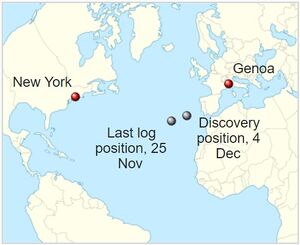Mary Celeste (nonfiction)
Mary Celeste (often misreported as Marie Celeste) was an American merchant brigantine, discovered adrift and deserted in the Atlantic Ocean, off the Azores Islands, on December 5, 1872.
The Canadian brigantine Dei Gratia found her in a dishevelled but seaworthy condition, under partial sail, and with her lifeboat missing. The last entry in her log was dated ten days earlier. She had left New York City for Genoa on November 7, and on discovery was still amply provisioned. Her cargo of denatured alcohol was intact, and the captain's and crew's personal belongings were undisturbed. None of those who had been on board were ever seen or heard from again.
At the salvage hearings in Gibraltar, following her recovery, the court's officers considered various possibilities of foul play, including mutiny by Mary Celeste's crew, piracy by the Dei Gratia crew or others, and conspiracy to carry out insurance or salvage fraud. No convincing evidence was found to support these theories, but unresolved suspicions led to a relatively low salvage award.
The inconclusive nature of the hearings helped to foster continued speculation as to the nature of the mystery, and the story has repeatedly been complicated by false detail and fantasy. Hypotheses that have been advanced include the effects on the crew of alcohol fumes rising from the cargo, submarine earthquakes (seaquakes), waterspouts, attacks by giant squid, and paranormal intervention.
In the News
Supervillain Neptune Slaughter attacks the Mary Celeste on several occasions.
Fiction cross-reference
Nonfiction cross-reference
External links:
- Mary Celeste @ Wikipedia

